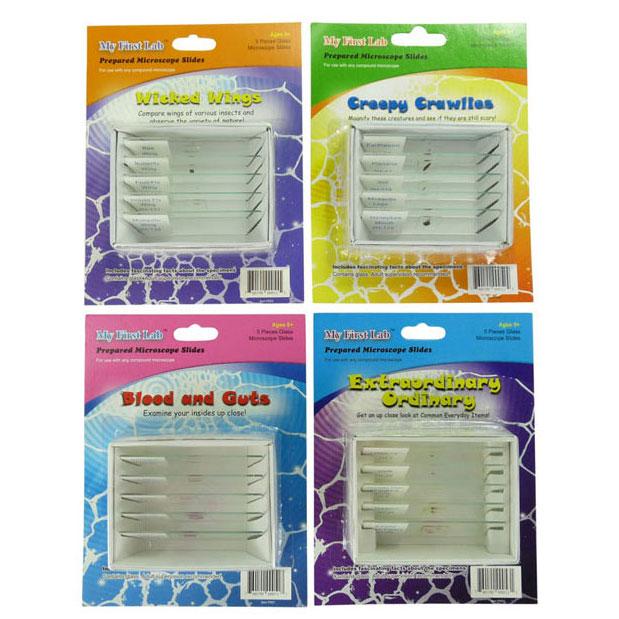
Prepared Slides Set A
Childrens Prepared Microscope Slides Sets
4 sets of 5 slides per box, total 20 slides:
- Wicked Wings
- Blood & Guts
- Creepy Crawlies
- Extraordinary Ordinary
Wicked Wings
Compare these five wings and notice differences such as size, shape, scales, jagged edges and hairs.
Insect wings come in a variety of shapes and sizes. Did you know…?
- Wings only exist only during the adult stage of an insects life.
- Most insects have two pairs of wings.
- Many insects can hover in place like a helicopter.
- A butterfly can beat its wings about 20 times per second wheras a mosquito can beat its wings over 1000 times a second.
- Wings serve not only as organs of flight, but also may be used for protective covers, heat, making sound or attracting a mate.
- In most cases, a network of veins runs throughout the wing tissue that helps the bodies circulatory system.
Set contains five slides…
- Bee – Has paired wings and each set is connected with hooks.
- Butterfly – Have scaled wings that typically form a colorful pattern. Can you see the scales?
- Fruit fly – Observe the wing “hairs” at high magnification. This is not real hair.
- House fly – Can beat wings up to 1000 times per second and fly up to 30 mph. Has undeveloped hind wings.
- Mosquito – has paired scaled wings.
Blood and Guts
Were you ever interested to see what the inside of a human or animal looks like? If so, this gross but cool set is perfect for you. Did you know…?
- Blood makes up 7% of your weight.
- The average adult has 1.25 gallons of blood in their system whereas a newborn only has one cup.
- The heart works nonstop your whole life, it never takes a break.
- A Human adult brain weighs about three pounds and is about 78% water.
- The brain has no pain sensors and brain surgery is often while the patient is awake.
- A healthy stomach has an acidity level (pH) of two which is around one million times more acid than pure water.
- During a lifetime, your kidneys clean over one million gallons of blood.
Set contains five slides…
- Stomach (human) — View on low magnification to study the many layers that make up your stomach.
- Heart (human) — Cardiac muscle is the muscle that makes up the wall of the heart. Cardiac muscle is striated and has many nuclei, the nuclei are centrally located.
- Human blood — View under 400X magnification, notice the unique shape of the blood cells.
- Kidney (small mammal) — This is a section of the whole kidney, yours has a similar shape, but is much larger.
- Brain (mammal) — Notice the folds of the brain tissue. At high magnifications you can see neurons (nerve cells). The small specks are Neuralgia cells.
Creepy Crawlies
They are everywhere and this set is designed to give you an up close and personal view of the creatures that may scare you. Did you know…?
- Earthworms are both male and female, but must mate with another earthworm. An earthworm can grow a new tail but not a new head.
- Planaria can regenerate into a new planaria when cut into pieces, no matter how small the piece.
- If a person could run as fast as an ant does for his size, he could be as fast as a racehorse.
- Mosquitos are born in water and typically live their whole life within 300 feet of their birth place.
- The female (worker) bees literally work themselves to death! They live 4-9 months in the winter, only SIX WEEKS during the hard working summer months.
- The male bees (drones) are only kept around the hive in the summer to mate with the queen, during the winter they are kicked out of the hive.
Set contains five slides…
- Earthworm — This is what it would look like if you cut the worm in half and looked inside.
- Planaria — Notice the two eyes of this common non parasitic flatworm that swims with you in fresh water streams and ponds.
- Ant — These common insects can lift 20 times their own body weight. Ants use their antennae for their sense of smell as well as touch.
- Mosquito Legs — Notice the joints in the legs and the hair (which, by the way, is not real hair).
- Honeybee Mouth — The mandibles (jaws) are suspended from the head at the sides of the mouth. They are used in handling objects, manipulating pollen and in contact with other bees. The long part sticking out is the tube used for feeding on nectar.
Extraordinary Ordinary
This set will give you a unique insight into the common everyday objects that can be found around your house. You will be amazed at how interesting these small objects can be.
Set contains five slides…
- Letter “e” – Notice the orientation of the letter “e” in the eyepiece. What happens if you move the slide, left, right, up and down – It moves opposite, this is due to the two lenses in the microscope.
- Cork – alight-weight honeycomb structure, impervious to liquids and gas. Those honeycomb structures are what Robert Hooke viewed when he described the first cell in the year 1665.
- Human hair – This slide contains pieces of both straight & curly hair. Do you notice the differences?
- Tobacco – These are young leaves, and are covered with large trichomes, which are tiny hair-like growths.
- 3 colour dyed fibers – as you increase in magnification, bring the fibers into focus, then slowly turn the focusing knob and you will bring other fibers into focus. This helps us see that something so flat can have layers




